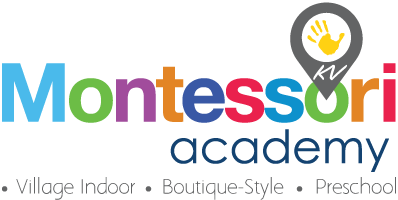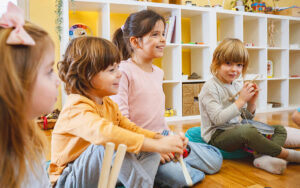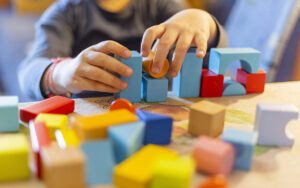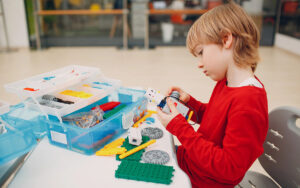Montessori education believes children learn best when they do, touch, and explore. Hands-on learning turns curiosity into understanding and experience into mastery.
In a world filled with screens and fast information, hands-on learning feels refreshingly real. It reminds us that the best lessons often happen not from watching but from doing.
At KV Montessori, this philosophy is at the heart of every classroom. Children are encouraged to explore, manipulate, and experiment with the world around them. Whether pouring water into cups, tracing letters in sand, or fitting geometric shapes into wooden frames, each task helps them understand ideas through movement and experience.
“When children use their hands, they engage their minds and open the door to deeper understanding.”
Learning by Doing: The Montessori Way
Maria Montessori observed that children learn through active engagement. She called this process “learning through the hand,” recognizing that movement, touch, and exploration are not just physical activities but essential parts of cognitive development.
In a Montessori classroom, every material is designed with a purpose. A set of color tablets teaches both art and categorization. Bead chains introduce math concepts like counting, multiplication, and patterns. Pouring exercises, polishing tasks, and buttoning frames build fine motor control while teaching independence and responsibility.
Children are not just told what to do—they experience why something works. This direct connection between action and result strengthens memory, concentration, and problem-solving skills.
The Science Behind Hands-On Learning
Modern neuroscience supports what Montessori discovered more than a century ago: the hand and the brain develop together. When children manipulate objects, multiple parts of the brain engage simultaneously—visual, sensory, and motor regions work in harmony to reinforce learning.
This kind of engagement builds neural connections that are far stronger than those created by passive observation. It transforms abstract concepts into something tangible. A child who stacks number rods or counts golden beads is not memorizing math; they are feeling math.
Research also shows that hands-on learning improves attention span and retention because it invites curiosity. When children participate actively, they form personal connections to what they learn—and that emotional connection helps knowledge stick.
“Children remember what they discover, not just what they are told.”
Hands-On Learning Builds Independence
Montessori materials are designed for self-correction and self-discovery. When a child builds a tower that falls, they naturally learn balance and precision. When they fit a cylinder into the wrong hole and it does not fit, they adjust, reflect, and try again.
This process builds confidence, patience, and independence. Instead of relying on adults to confirm success, children learn to observe and assess their own work. Each mistake becomes a gentle teacher rather than a setback.
Over time, this hands-on approach nurtures persistence and problem-solving—skills that extend far beyond the classroom. Children who learn to solve small challenges independently often grow into adults who approach life’s bigger challenges with calm focus and resilience.
From Concrete to Abstract Understanding
One of the most powerful aspects of the Montessori method is its natural transition from concrete learning to abstract thinking. Children begin by handling real objects before moving toward symbolic representation.
For example:
- A child first counts tangible objects, like wooden beads.
- Later, they recognize written numbers that represent those quantities.
- Eventually, they can perform mathematical operations mentally, having built a solid foundation through experience.
This progression mirrors how the brain naturally develops. Starting with hands-on exploration ensures children fully understand why something works before being asked to memorize it. The result is deeper comprehension, lasting confidence, and true mastery.
Emotional and Social Benefits of Active Learning
Hands-on learning also supports emotional development. When children work with materials, they experience the satisfaction of completion, the pride of mastery, and the patience of repetition.
These moments build self-esteem and encourage collaboration. In a Montessori classroom, children often work side by side, sharing materials, observing each other’s methods, and offering help when needed. This cooperative environment promotes empathy and community, key components of social-emotional growth.
Children quickly learn that learning itself is rewarding—not because someone praises them, but because it feels good to achieve something through effort and curiosity.
Hands-On Learning at Home
Parents can easily extend this principle at home. Everyday routines can become meaningful learning experiences when children are allowed to participate. Some examples include:
- Letting your child measure ingredients while cooking
- Encouraging them to sort laundry by color or size
- Providing open-ended materials like blocks, clay, or art supplies
- Allowing time for unstructured exploration outdoors
These small actions strengthen motor coordination, focus, and independence while reinforcing the joy of discovery.
“Children thrive when their hands and hearts are both engaged in learning.”
A Lifetime of Curiosity and Confidence
At KV Montessori, hands-on learning is not just a teaching method—it is a mindset. It helps children build confidence through exploration, develop deep concentration, and see mistakes as opportunities for growth.
By connecting knowledge to real-world experiences, Montessori education ensures that learning feels alive, meaningful, and joyful. When children truly experience their education, they carry that curiosity and confidence into every part of their lives.
If you would like to learn more about our approach to experiential learning and see how Montessori materials inspire discovery, schedule a tour today. Experience the joy of learning through doing.






